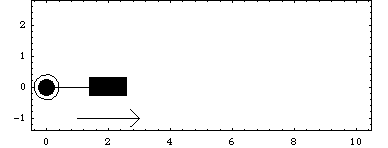10.5.1 Example MechanismThe following planar example is probably one of the more common nonholonomic systems, a caster, such as a wheel on a shopping cart. The caster is modeled in two dimensions by viewing the caster from above, like looking down through the shopping cart. The steady state motion of a caster is for the wheel to trail directly behind the pivot point of the caster. What is modeled here is the motion of the caster when the direction of travel of the pivot is reversed. The caster swings out to one side of the pivot and then settles in behind the pivot again.
The wheel of the caster is modeled as a single nonholonomic constraint that constrains the direction of travel of the wheel to be parallel to the direction that the wheel is pointed. In vector algebra terms the velocity vector of the wheel is perpendicular to a vector through the wheel's axis of rotation. Normal Mech constraint functions can be used to model first-order relationships such as this by making at least one of the geometry specifications in the constraint a function of velocity.
Before the velocity constraint can be put in place by SetPath the model must be built in a normal kinematically constrained way. This requires a dummy constraint that will be replaced by SetPath later. The dummy constraint is a RotationLock1 constraint to lock the rotation of the caster relative to the ground. The other constraint in the model, constraint 1, simply constrains the pivot point of the caster to move steadily along the global X axis. This loads the Modeler2D package. Here is a pair of constraints for the 2D caster model. The second constraint will be replaced with a velocity relationship by SetPath. The model is run just to make initial conditions available to SetPath. Here is the caster with zero initial angle.

|